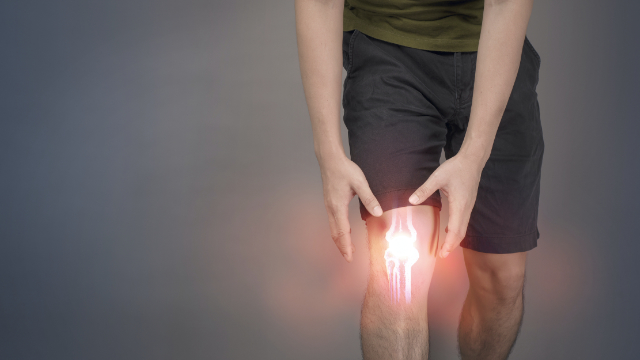
Knee osteoarthritis is an extremely common disorder that involves the cartilage in a knee joint. In a normal knee, the ends of each bone are covered by cartilage, a smooth substance that protects the bones from one another and absorbs shock during impact. In knee osteoarthritis, this cartilage becomes stiff and loses its elasticity, which makes it more vulnerable to damage. As cartilage wears away over time, it loses its ability to absorb shock, thereby reducing the amount of space between bones and increasing the chances that the two bones will contact one another. The most common symptom of knee osteoarthritis is pain that gets worse with activity, while swelling, tenderness, and stiffness may also occur in some patients.
Knee osteoarthritis is particularly common in older adults, as it affects about 45% of individuals and represents the most common cause of pain in this population. Although no treatment can slow or stop this loss of cartilage, physical therapy is strongly recommended as an initial intervention for all patients with knee osteoarthritis. Undergoing a course of physical therapy can help reduce pain levels and preserve knee function through movementâbased strategies like stretching and strengthening exercises, handsâon (manual) therapy, bracing, and lifestyle recommendations.
Patients with knee osteoarthritis are also encouraged to increase their physical activity levels to reduce their pain levels and improve functional capacity, but some healthcare providersâand patientsâare uncertain how physical activity affects the structural integrity of the knee and if it can be safely performed by patients. Therefore, a study was conducted to examine the safety of physical activity for patients with knee osteoarthritis.
Consistent evidence shows that many common forms of physical activity are safe
Researchers performed a search of the PubMed database for reviews and highâquality studies that evaluated the biological effects of physical activity on the knee in patients with knee osteoarthritis, and the search led to 20 reviews and 12 original studies being included. Upon reviewing these studies, researchers found consistent evidence that many common forms of physical activityâlike walking, running, and certain recreational sportsâare not associated with structural progression of knee osteoarthritis. Based on their findings, researchers stated that these types of physical activity can be safely recommended for patients with knee osteoarthritis and those at risk for getting it. Evidence was also found that some patients with knee osteoarthritis may benefit from specific recommendations that address other risk factors present, such as weightâloss strategies and treating previous knee injuries.
From here, researchers went on to make the following recommendations for patients with knee osteoarthritis:
- Brisk walking is strongly recommended for all patients; to meet the World Health Organizationâs guidelines for â¥150 weekly minutes of moderateâintensity physical activity, patients can consider going on 5 30âminute walks each week
- Patients with knee osteoarthritis who are already runners are encouraged to continue running, as recreational running for up to 25 miles per week was not associated with an increased risk of structural progression of knee osteoarthritis
- Recreational sports are generally encouraged, but patients should speak to their healthcare providers about which sports are safest, since some sports (eg, soccer, weightlifting, wrestling) may increase the risk for knee osteoarthritis progression
If you have knee osteoarthritis and are interested in becoming more physically active, our physical therapists can help by setting you up with a personalized exercise program that carefully considers your physical limitations.
